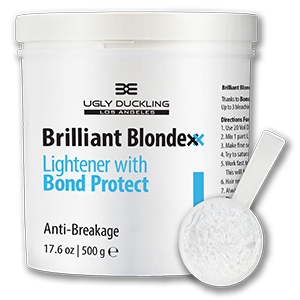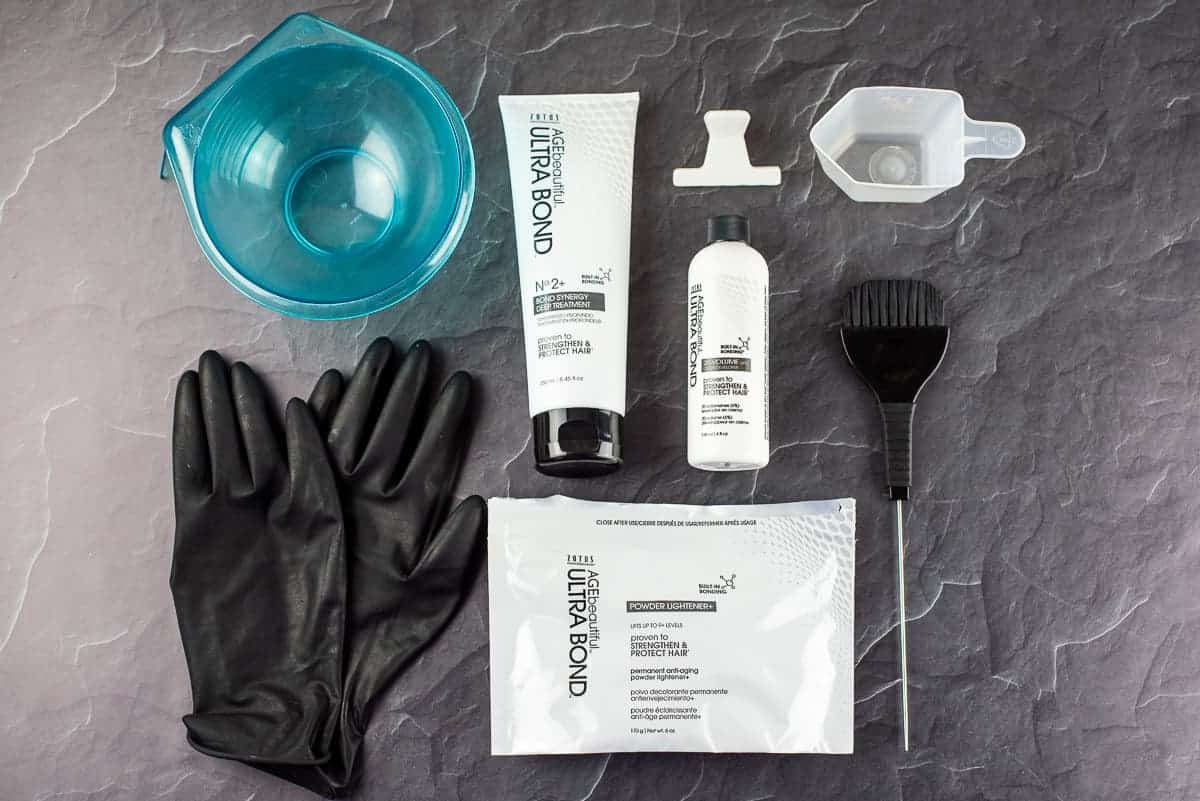Bleaching your hair at home? You have to get the ratio of bleach to developer right, especially if you have long or dark hair. It matters if you use a 20 developer, 30 developer, or 40 developer.
We always suggest going to a professional hairstylist to get a bleach job, but for many people, this has become difficult due to current circumstances.
And we’ve seen one horror story after another about bleaching hair at home gone wrong. And these usually have to do with using the wrong bleach-to-developer ratio.
So in this article, we’ll talk about the proper ratio of bleach to developer you should use while mixing them together. This ratio is also applied for bleaching hair extensions!
I. What Type of Bleach You Should Use?
A good quality lightener which will lift quickly and efficiently without breaking or damaging is really essential. If you are looking to do near-scalp bleaching, or if your client is excessively fine and fragile and prone to breakage, we recommend Brilliant Blondexx lightener with Bond Protect. This bleach is very safe and has excellent lifting properties.

Thanks to the Bond Protect technology, it protects your hair from breakage as you lift it. It is also gentle enough to use on the near-root area and near-scalp bleaching with minimal scalp irritation.
II. What Do You Need To Have Apart From Bleach?
In addition to your bleach, you will also need:
- A developer – 20, 30, or 40 Volume
- A hair toner
- Purple shampoo and mask for afterward (optional)

You will also need application tools, including rubber gloves, a couple of brushes and bowls, a kitchen weighing scale, and a timer.
III. What Developer Should I Use With Bleach?
1. What Exactly Developer Are?
A developer or activator is nothing but hydrogen peroxide that helps in lifting the hair cuticles making it easier for bleach to remove the color pigments. The number on the developers signifies its oxidation potential or strength. So the bigger the number the more effective it is at removing hair color. But at the same time, it’s also more corrosive and damaging.

Now there are developers ranging from 10 to 40. A 10 developer is very mild and doesn’t exactly lighten hair just brings it down a tone or two. 20 and 30 developers are the most commonly used ones. The 20 developer can lift hair up to 2-3 levels and the 30 developer up to 4 levels.
So what about the 40 developer? Well, it’s very powerful and it can lift hair up to 6 levels. But trust me it’s too strong to mess with at home. It contains 12 percent peroxide and is known to cause burning and scabs on the scalp when used to dye roots.
2. What Developer Should Use With Bleach?
As we mentioned in the previous sections, 20, 30, or 40 developer are only assigned these numbers to indicate how much they lift your existing hair color. Not an indication of how many developers to add.
- If you are aiming to lift by 1-2 levels, you need a 20 Vol developer.
- You will need a 30 Vol developer if you are aiming to lift by 3-4 levels.
- When you are working with very dark hair, then you may need to do the first application with a 30 Vol developer and then make a second application using a 20 Vol developer. Just make a fresh mix and reapply on the bleached hair while it is processing – no need to rinse and then bleach.
- For the root area, it should be 20 Vol developer only. It processes fast due to the heat from the scalp.
- If you are trying to get to ash or platinum blonde, you must lift all the way up to level 10, so 40 Vol developer is the proper type.

Use this level guide to assess how much bleaching is necessary in your case & which developer you are going to need.
IV. Exact Ratio Of Bleach To The Developer You Should Use (20, 30, 40 Developer)
Given below is the correct ratio of bleach to developer you should use depending on the type of developer:
- 20 developer to bleach ratio – 2:1
- 30 developer to bleach ratio – 2:1
- 40 developer to bleach ratio – 2:1
Surprised? Yup. The amount of developer you use on the bleach has got nothing to do with the strength. Indeed, most hairstylists suggest using two parts of the developer for every one part of bleach as this ratio gives you the right consistency of the liquid.
This ratio gives you a fairly runny texture of bleach that can be easily applied to hair. This consistency is good for long hair as it drips down enough to spread throughout the tresses, but it’s not thin enough to go down your face.
For The Bleach Packet:
Here is a quick guide if you’re using a developer and bleach packet:
- For every 50gm bleach powder, you’ll need 100gm of developer
- For every 100gm of bleach, you’ll need 200gm of developer
If you’re using ounces instead of grams the ratio will be the same.
- For every 1oz of bleach, you’ll need 2oz of developer
- For every 2oz of bleach, you’ll need 4oz of developer
If you use too much developer your mixture will end up runny and can get on your face, skin, etc. causing burning and inflammation. If you use too little developer the mixture will be too thick and won’t adhere to hair well. This will cause uneven bleaching.
*Note: This ratio of 2:1 will change if you’re planning to bleach your hair for a balayage. We do NOT want the bleach to spread all over in case of a balayage. So a thicker paste is required when doing a balayage or covering up small areas of hair. In this case, you should use the bleach and developer in a ratio of 1:1. With only one part of developer added to one part of bleach.*
How To Measure Bleach And Developer?

You shouldn’t have too much difficulty in measuring the bleach and developer as most bleaching kits come with measuring tools like a spoon that you can use to get the right ratio.
However, if such thing isn’t unavailable you can use old measuring spoons you’ve got in your kitchen that are used to measure baking ingredients.
Just remember to wash and dry them thoroughly before use and never use these spoons for measuring food once you’ve got bleach in them.


 BEST SELLING PRODUCTS
BEST SELLING PRODUCTS Wig Hair
Wig Hair WHOLESALE
WHOLESALE Contact us
Contact us Sale Events
Sale Events
